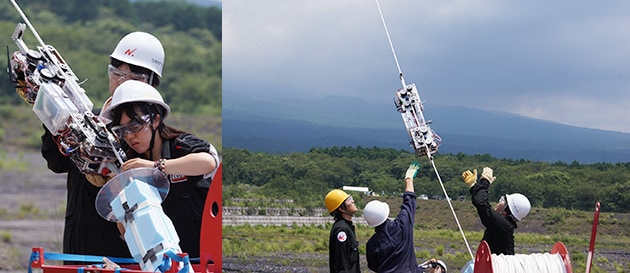
- Semiconductor Technology Now
Technology
Space elevator technology competition held annually since 2009
The Japan Space Elevator Association (JSEA) has been actively promoting construction of space elevators. Its mission is to accumulate and share knowledge necessary for space elevator construction and develop enabling technologies to support its early realization. Among the association’s unique activities is the Japan Space Elevator Technical & Engineering Competition that has been held annually since 2009. (After the fourth competition that took place in 2012, the event will change its title to Space Elevator Challenge in 2013.) The participants set their climbers to a tether hung from a helium balloon floating high up in the air, and compete how fast the climbers go up and down. The balloon has been flown higher every year, and in the 4th year it was supposed to reach 1,200 meters, but it only went as high as 780 meters because of the balloon burst and other troubles. In the 2012 competition in which 16 teams participated, the climber by Nihon University’s Irie Laboratory team was the fastest, attaining an average speed of 54 km/h and the maximum momentary speed of 105 km/h. The climbers entered in this competition do not necessarily qualify for use on an actual space elevator, but the event serves as an incubator of promising technologies for future space elevators. The competition also gives young engineers an opportunity to take on new challenges. “Mankind has already created almost all vehicles that travel by land, sea, or air, so all we can do with them is to improve on the existing technologies,” says Aoki. “But a space elevator is still a work in progress, so there is no right answer yet. That is why I encourage young researchers to participate in this event and experience the joy of creating something from a clean slate.”
 |
Cargo transportation as a warm-up for passenger travel
When a space elevator is built, it will initially be used as a cargo transporter before steps can be taken to carry passengers. Since space is full of high-energy radiation known as cosmic rays, measures to protect passengers against exposure must also be taken. But the fact remains that our planet is becoming more crowded than ever, with the total population expected to reach 9 billion or more by 2050. Going into space to look for a new habitat may not be a sci-fi scenario anymore.
“Unless we start making preparations now, we will never be able to build a space elevator by 2050,” says Aoki. “Performing simulations is not enough. The process of physical experimentation is crucial to the success of a project like this. That is why I think our activities will be of material help in making space elevators a reality. So I’m committed to promoting the events like the space elevator technology competition.”
The path to building a space elevator is by no means easy, but the daring construction project reaching out into space is worth pursuing with the united efforts of all mankind.
Writer
Hideo Ishii
Born in 1970, Ishii completed a master’s program in material science at the University of Tokyo’s Graduate School of Engineering.
He started contributing reviews to personal computer magazines while he was still a student, and became a full time writer after graduation. While Ishii’s scientific interest is broad in scope, he is particularly knowledgeable about computer hardware including notebook PCs, mobile devices, and DIY PCs. Ishii frequently contributes to such publications as Weekly ASCII, ASCII.jp, and PC Watch. He has authored or co-authored over a dozen books and mooks.



















